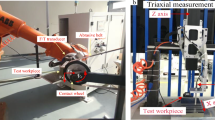Abstract
In the present paper, a new grinding force model is developed by analyzing and assessing the robotic abrasive belt grinding mechanism which is based on the fact that the chip formation during grinding process consists of three stages: ploughing, cutting and sliding. Then the grinding depth is predicted by the grinding force model to realize quantitative machining in the robotic belt grinding process. Next the grinding parameters optimization are implemented to further ensure the workpiece surface quality and profile accuracy with force control technology applied. Finally, a typical case on robotic abrasive belt grinding of test workpiece and aero-engine blade is conducted to validate the practicality and effectiveness of the grinding force model.
Access this chapter
Tax calculation will be finalised at checkout
Purchases are for personal use only
Similar content being viewed by others
References
Zhao, T., Shi, Y., Lin, X., Duan, J., Sun, P., Zhang, J.: Surface roughness prediction and parameters optimization in grinding and polishing process for IBR of aero-engine. Int. J. Adv. Manuf. Technol. 74, 653–663 (2014)
Zhao, P., Shi, Y.: Posture adaptive control of the flexible grinding head for blisk manufacturing. Int. J. Adv. Manuf. Technol. 70, 1989–2001 (2014)
Huang, H., Gong, Z.M., Chen, X.Q., Zhou, L.: Robotic grinding and polishing for turbine-vane overhaul. J. Mater. Process. Technol. 127(2), 140–145 (2002)
Ren, X., Kuhlenkötter, B.: Real-time simulation and visualization of robotic belt grinding processes. Int. J. Adv. Manuf. Technol. 35(11), 1090–1099 (2008)
Kountanya, R., Guo, C.: Specific material removal rate calculation in five-axis grinding. J. Manuf. Sci. Eng. 139(12), 121010 (2017)
Ardashev, D.V., Dyakonov, A.A.: Mathematical model of the grinding force with account for blunting of abrasive grains of the grinding wheel. J. Manuf. Sci. Eng. 139(12), 121005 (2017)
Zhang, X., Kuhlenkötter, B., Kneupner, K.: An efficient method for solving the Signorini problem in the simulation of free-form surfaces produced by belt grinding. Int. J. Mach. Tools Manuf. 45(6), 641–648 (2005)
Wang, Y.J., Huang, Y., Chen, Y.X., Yang, Z.S.: Model of an abrasive belt grinding surface removal contour and its application. Int. J. Adv. Manuf. Technol. 82(9–12), 2113–2122 (2016)
Dai, C., Ding, W., Xu, J., Fu, Y., Yu, T.: Influence of grain wear on material removal behavior during grinding nickel-based superalloy with a single diamond grain. Int. J. Mach. Tools Manuf. 113, 49–58 (2017)
Jourani, A., Hagege, B., Bouvier, S., Bigerelle, M., Zahouani, H.: Influence of abrasive grain geometry on friction coefficient and wear rate in belt finishing. Tribol. Int. 59, 30–37 (2013)
Tang, J., Du, J., Chen, Y.: Modelling and experimental study of grinding forces in surface grinding. Ann. CIRP, 1–8 (2008)
Zhu, D., Luo, S., Yang, L., Chen, W., Yan, S., Ding, H.: On energetic assessment of cutting mechanisms in robot-assisted belt grinding of titanium alloys. Tribol. Int. 90, 55–59 (2015)
Zhu, D., Xu, X., Yang, Z., Zhuang, K., Yan, S., Ding, H.: Analysis and assessment of robotic belt grinding mechanisms by force modeling and force control experiments. Tribol. Int. 120, 93–98 (2018)
Wang, W., Liu, F., Liu, Z., Yun, C.: Prediction of depth of cut for robotic belt grinding. Int. J. Adv. Manuf. Technol. 91(1–4), 699–708 (2017)
Murtagian, G.R., Hecker, R.L., Liang, S.Y., Danyluk, S.: Plastic deformation depth modeling on grinding of gamma Titanium Aluminides. Int. J. Adv. Manuf. Technol. 49(1–4), 89–95 (2010)
Xu, X., Zhu, D., Wang, J., Yan, S., Ding, H.: Calibration and accuracy analysis of robotic belt grinding system using the ruby probe and criteria sphere. Robot Comput. Integr. Manuf. 51, 189–201 (2018)
Durgumahanti, U.S.P., Singh, V., Rao, P.V.: A new model for grinding force prediction and analysis. Int. J. Mach. Tools Manuf. 50, 231–240 (2010)
Venkatachalam, S., Liang, S.Y.: Effects of ploughing forces and friction coefficient in microscale machining. J. Manuf. Sci. Eng. Trans. ASME 129, 274–280 (2007)
Acknowledgements
The authors would like to gratefully acknowledge the financial support from the National Nature Science Foundation of China (nos. 51675394, 51375196), the National Key Research and Development Program of China (nos. 2017YFB1303400), the State Key Laboratory of Digital Manufacturing Equipment and Technology (no. DMETKF2018018), and the Fundamental Research Funds for the Central Universities (no. 2017II33GX).
Author information
Authors and Affiliations
Corresponding author
Editor information
Editors and Affiliations
Rights and permissions
Copyright information
© 2018 Springer Nature Switzerland AG
About this paper
Cite this paper
Xu, X., Yang, Y., Pan, G., Zhu, D., Yan, S. (2018). A Robotic Belt Grinding Force Model to Characterize the Grinding Depth with Force Control Technology. In: Chen, Z., Mendes, A., Yan, Y., Chen, S. (eds) Intelligent Robotics and Applications. ICIRA 2018. Lecture Notes in Computer Science(), vol 10984. Springer, Cham. https://doi.org/10.1007/978-3-319-97586-3_26
Download citation
DOI: https://doi.org/10.1007/978-3-319-97586-3_26
Published:
Publisher Name: Springer, Cham
Print ISBN: 978-3-319-97585-6
Online ISBN: 978-3-319-97586-3
eBook Packages: Computer ScienceComputer Science (R0)



